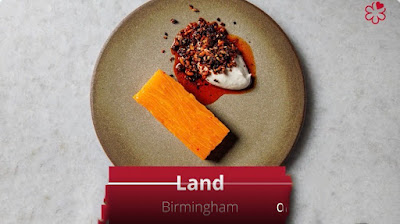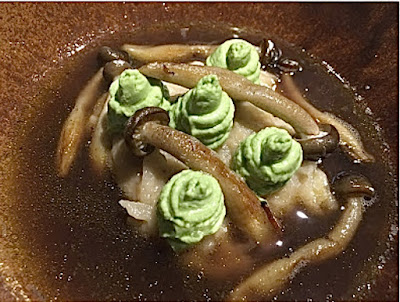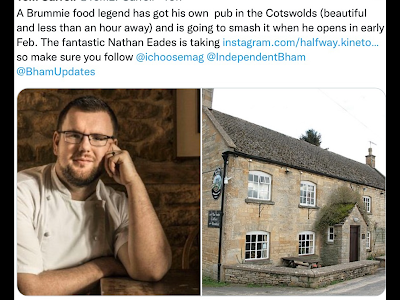Harden’s restaurant guide published, in the last few days, its list of the ‘UK’s Best Restaurants 2023’. How useful an exercise has that proven to be? Harden’s’ opinions are given based on those from its readers which is rather similar to The Good Food Guide. Its readers on the whole, judging by their opinions which presumably are based on the restaurants wherein they have eaten, are comfortably off, conservative with a small ‘c’ and moderately tutored in fine dining. I have an acquaintance who submits his opinions to the editors fairly frequently - he is not a food lover but enjoys analysing each course and searching for something to moan about (or very rarely praise) - he also sees himself as an amateur art critic and enjoys dissecting the elements of a painting and commenting on them without enjoying the whole.
Hence I wonder at the usefulness of a restaurant guide which relies on people such as my acquaintance or those who are self-selecting by their wealth, conservatism and moderate knowledge to pinpoint the leading restaurants in the country. I assume that most of the opinions expressed by those from this privileged group are also identifiable by place of residence of this group - London and its well heeled suburbs - and the places where they have second homes - the south west, the Lake District, Oxfordshire, the Cotswolds - plus a similar well-off population in Scotland, notably in Edinburgh. These people have very few qualifications, apart from wealth and location of home(s) to pronounce on what are the best restaurants in the United Kingdom but they do so and that is why the list is dominated by restaurants in the locations mentioned above.
It is also, I suspect, why it is routine for the West Midlands to be poorly represented in Harden’s’ 100. This year we are genuinely congratulating our restaurants that have received a mention but at the same time must feel deflated that only four West Midlands restaurants appear on the list - Adam’s at number 17, Lumière in Cheltenham (number 21), Opheem (60) and The Wilderness at number 92.
Meanwhile, around the same time, an internet-based restaurant site, of which I was not even aware previously, called Squaremeal, which appears to have been in business since 1990, announced it too had prepared a list of the United Kingdom’s ‘100 Best Restaurants’ and the results were very different from those of Harden’s’ list - many more West Midlands restaurants appeared on it. The site appears to be a restaurant and hotel booking site with an accompanying critique of the places bookable on it.

The Squaremeal list placed Grace and Savour at the very top of its list - number 1 - with other West Midlands following - Opheem (7), Pensons in Tenbury Wells (38), Lunar Stoke-on-Trent (43), Lumière (46), Carter’s of Moseley (51), The Wilderness (61), Adam’s (65), Purnell’s (72), The Old Butcher’s, Stow on the Wold (82), Chakana (97) and The Slaughters Manor House, Lower Slaughter (98). In the list there is finally recognition that the West Midlands is punching well above its weight when it comes to gastronomy. It does not recognise Cheal’s which is a glaring omission and in my opinion there is room for Folium on the list as well, not forgetting Andrew Sheridan’s remarkable 8, Upstairs by Tom Shepherd and Liam Dillon’s The Boat, both in Lichfield, Sheridan’s Black And Green in Barnt Green, Shrewsbury’s The Walrus and Hampton Manor’s other restaurant Smoke and Toffs in Solihull. The West Midlands could quite easily occupy at least 20% of a ‘UK Top 100’ list.
What is clear is that guides and lists are not necessarily all that helpful. Where Harden’s can only find four WM restaurants to place in its top one hundred, Squaremeal can find twelve and place one of them at the very peak of its list. Squaremeal seems the better judge, as The Good Food Guide identified Birmingham as the most exciting UK city in which to dine at the end of last year and placed three Birmingham restaurants in its top twenty ‘most exciting’ restaurants list. And over them all looms the Michelin Guide, its recognition the most craved by chefs. It is conservative, impenetrable, obscure and often its decisions are inexplicable and abstruse, more inconsistent than its editors would admit and ultimately for these reasons, of less value than it thinks it is. The Michelin Guide’s underlying French-style food bias remains though it may deny it - it has glued itself to the book for eternity - this may have snob appeal but it does not necessarily result in a British diner sitting at a table enjoying the often expensive food laid before him.
In contrast The Good Food Guide seems much more alive, more relevant, in step with taste but does seem in danger of being dragged away too far from the mainstream - listing hipster haunts, furnished in shabby style, uncomfortable, where good food is indeed served but with nothing else to make the meal a pleasure.
So when it comes to Guidebooks or websites - Caveat emptor. Take a pinch of salt when you’re reading them and doublely so when it comes to ‘Best restaurant’ lists. Consider who are the people who have rated the restaurants, are they shadowy elitist figures or an untutored vox populi or trendy self-loving influencers? Personally, I like a good newspaper reviewer; with regular reading of their articles, one knows their prejudices, their pleasures, their dislikes and with those in mind one can put their informed opinions in context and judge the validity of their opinions and consider how that match with one’s own.
On the subject of which, I enjoyed a recent piece by Jay Rayner in The Guardian, a paper I otherwise can not bear to read, on the future of fine dining and, in particular, the horrors of the twenty plus course tasting menu which may bring one many delights but also an angor animi as the meal drags on, the hours pass and the realisation dawns that there are still another nine courses to ingest - it’s a bit like a direct flight from New Zealand - you’ve been in the air for sixteen hours and you realise that there’s still another eight to go before you touch down in dear old Blighty.
There was another piece recently by a writer for The Financial Times - Janan Ganesh, more a political writer than a food critic but apparently he has devoted the past year travelling around fine dining (haven’t we all?) and in it he gave his opinion on “what to look for in a restaurant”, presumably a restaurant of the Now, of where fine dining is going. He arrives at all sorts of depressing conclusions - “the neighbourhood must be hipster” (groan), the “view must be rubbish” (goodbye to the bib gourmand and no herds of wildebeest sweeping majestically past the window), “staff mustn’t ask if you’re enjoying your meal” (should they just scowl at you, perhaps? What about the size of their gratuity?), “champagne must come in a wine glass (the modern triumph of lack of substance over style) and “the kitchen must be unconfidential” (really I am there to eat and enjoy and not to watch men work no matter how nice modern head chefs are to their staff). Newnham-Davis is turning in his grave.

Coincidently Mr Ganesh was dining at The Wilderness when I was there for dinner a couple of week’s ago, doubtless continuing his mission to dine. I suspect there’s a book planned at the end of it - well he is a journalist - and now we know that Birmingham should have a place in it. I revisited The Wilderness three or four nights ago. The Jewellery Quarter was very dark, damp and moderately misty, the streets virtually deserted and the little passageway at the end of which was the prettily-lit entrance to the restaurant, had all the feeling of a Brummie version of 1880s Whitechapel about it. No wonder then that the restaurant was not fully booked on this mid-winter evening. But the punters there were treated to a magnificent repast - basically the same ‘Future of Dining’ menu from which I had dined a couple of weeks before but brilliantly executed. The wagyu beef was immaculate and generously portioned on this occasion, and in the fish course, pollock had transformed very pleasingly into turbot. The petit fours were also different from two weeks before with a charming cow’s head fudge sitting prettily on the plate beside a yuzu jelly. Chef Marius Gedminas was in cracking form and after a slight wobble at the end of last year one evening, The Wilderness was unquestionably still up there among the stars.
‘Carrot 2023’ -
Chicken broth with egg yolk and seaweed -
Magnificent wagyu with a fine sauce -
Seared Anjou pigeon with foie gras-stuffed paratha -
Petit fours - Cow’s head fudge and yuzu jelly -
There’s certainly a new future in store for a couple of West Midlands established chefs - Matt Cheal of Cheal’s of Henley is putting his final preparations in place for his new restaurant in Knowle and Nathan Eades, Yorkshire-born but raised in Bromsgrove, once a sous chef at Forelles in Fishmore Hall in Ludlow from which he operated a pop-up, Epi, firstly in Ludlow in 2012, then in Bromsgrove from 2013 with side trips to the Kitchen Garden in Kings Heath (January 2014) and then Head Chef at Simpsons (from 16 September 2015 succeeding, coincidently, Matt Cheal though it had previously been announced he was to be the Head Chef at St Andrew’s Hotel in Droitwich, and thence to the Wild Rabbit at Kingham, is to open his own pub restaurant, Halfway at Kineton.
Worldwide, the biggest gastronomic event of the year was the announcement that René Redzepi is to close his multi-course, astronomically priced restaurant
Noma in Copenhagen finding that since he started to pay his junior chefs a salary the restaurant’s financial model did not work. Famously, the restaurant has been judged by the
cognoscenti to be the best in the world but was it after all, just a side branch in the evolution of dining out which eventually fizzles out? Regardless, let’s face it, I was never going to get there.
Finally the grim news that the BBC’s Great British Menu returns to the nation’s television screens next week sadly with the same judges as last year, in particular the exquisitely irritating Ed Gamble who brings the BBC’s dumbing down to new previously unplumbed depths and that magnificent chef Tom Kerridge who dominates the other judges with his opinions. With the West Midlands in general, and Birmingham in particular, leading the country’s gastronomic scene, perhaps the programme’s producers might even feature chefs this year who actually work in West Midlands restaurants to represent the region. Oh, this year’s theme is a celebration of Paddington Bear and British animation so I suppose every chef will feel obliged to incorporate marmalade in their menus or strive to produce Anglo-Peruvian fusion dishes. Bring back Fort and Peyton. Please.

Finally, when staying in town, I am still enjoying taking Lucy The Labrador to breakfast in Wayland’s Yard in Bull Street. A rather delicious and very filling ‘Full English’ is on offer but I’m rather keen on the bacon bap, literally piles of well-cooked streaky bacon on a sweet bap, washed down by some of the café’s fine coffee. I like the amusing mural there, it has the air of this year’s Great British Menu theme about it.

























































